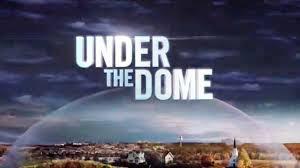Sleepy Hollow‘s first season finished last night with a typically crazy-town bonkers two-parter, capping off a ridiculously successful first season which proved pretty much everyone wrong as practically no one gave this show a chance (I know I didn’t). Suck it, stupid critics (again, I include myself in that group). All you need to make this show work is the right amount of self-aware humor, perfect casting (Tom Mison & Nicole Beharie as the two leads), gorgeous production design, and story lines which constantly teeter on the edge of over the top without going over the line.
However, if the show is so great why is it that we’re only in January and Fox just ended its first season last night? The overnight Nielsen ratings have been falling off, averageing 6.5 million viewers as of late after the pilot pulled in 10 million viewers. However, it is still easily Fox’s biggest new hit of the season. So, why would they then not extend it to a full 22-episode season?
Well, for starters, the show is coming back. Fox renewed it for a 13-episode second season a mere 3 episodes into its first season, with Fox’s CEO of Entertainment Kevin Reilly proclaiming:
“The show has proven to be a risk well worth taking – it’s a conceptual blast unlike anything else on television and it all holds together with inventive writing and a fantastic cast. I can’t wait for fans to experience what else is in store for this fall and even more of this wild ride into Season Two.”
That’s great, but, again, why not give it a full 22-episode first season instead of making us wait so long for the second season? If this were a couple of years ago, it seems highly likely that’s exactly what Fox would have done, simply exercise their “back-nine” on Sleepy Hollow. However, for those Hollow fans desperate for more you pretty much have cable to blame for what Fox has decided to do.

It really has nothing to do with this article, but just as a treat here’s Tom Mison exposing his chest on Sleepy Hollow. You’re welcome.
Ever since The Sopranos hit big on HBO in 1999, and USA’s The Dead Zone and Monk proved the viability of original summer programming in 2002 cable has been making rather convincing arguments for both the financial and artistic superiority of a 13-episode season for dramatic TV shows. As such, you’ve had cable outlets like HBO, Showtime, FX, TNT, USA, and AMC siphoning away viewers with more cinematic (well, not so much USA) original programming limited to shorter seasons. Plus, you have BBC America and PBS scoring big mostly with British shows for which they secure the American broadcast rights, and SyFy doing the same with Canadian shows as well as their own actual original programming. This decade long process took another turn over the past couple of years when cable networks like The History Channel scored huge ratings with a mini-series like The Bible.
As a result, the major networks are trying to figure out how to alter their traditional formats to be more like cable. Suddenly, phrases like “limited series” and “event programming” are all the buzz. The latter refers to live programming, such as NBC’s recent Sound of Music, and is also sometimes applied to a highly promoted, star-studded mini-series. A “limited series,” on the other hand, is kind of a meaningless phrase. Case in point, CBS’s Under the Dome was announced as a limited series implying it was only meant to air for one 13-episode season over the summer. However, when it got huge ratings CBS ordered a second season, to air at the same time next summer. In what way, then, is Under the Dome a “limited series”? It’s really just a network show airing with a cable-like running length. This is a disconnect that even ABC’s boss joked about at last week’s Television Critics Association (TCA) winter press tour.

Even if contained to 13 episode seasons, surely Under the Dome’s very premise will limit how long it can last. Eventually, those townspeople will just run out of supplies, right?
Now, Fox’s Kevin Reilly is taking things even further. He made headlines at the TCA press tour for his proclamations about how Fox is going to change the way things have been done historically at a broadcast network, such as bypassing the pilot stage of the TV show development process from this point forward. Specific to Sleepy Hollow, Reilly said he’s a huge believer in a 13 episode season for complicated dramas (from THR):
“It’s really the rare creator who can tell you where he’s going to end the season of 22 episodes. That’s not bad. That’s part of the creative exploration. But the challenge with that is sometimes really talented people, when they’re sleeping four hours a night and managing a hundred-million-dollar machine with hundreds of people producing it, they can lose their way. When you’re doing 13, you just feel like you’ve got a little bit more control of the ship.”
In addition to Sleepy Hollow, Fox has also been experimenting with shorter seasons for The Following, the short order believed to crucial to convincing never out of work film actor Kevin Bacon to commit to the project in the first place. However, just doing the shorter seasons isn’t enough. They need to figure out how to schedule these shows so that they are not constantly dropping off to make way for sports (MLB playoffs) or the holiday seasons or having to suffer through typically little watched re-runs:
“It’s a mess. People can’t watch television like that anymore. They can’t watch three on and one off and two on and one off and a holiday and an interruption. No one knows where it is. And believe me, that show, the producers would have liked to have 13 in a row — so did we. It is just humanly impossible to do when you’re making mini-movies every week. We were down to about two weeks’ post by the end. It’s just a joke. Next year, we’ll have 13 in a row.”
So, how will season 2 of Sleepy Hollow work:
“Sleepy Hollow, just to that note, here’s how year-round works: Most series come back. They’re picked up. Even the returning series, they’re picked up in the late spring. They get their feet under them again in the summer and they gear up. We will be starting next year’s production of Sleepy Hollow this March. We will be months ahead of everybody else.”
Reilly explained that by beginning production earlier than normal it will the episodes more time to be re-tooled along the way, if necessary. He also hinted they could end up adding a couple of more episodes to their initial 13-episode order for the second season. As for the ratings, he argued the Nielsen overnight rating is mostly meaningless at this point:
“Here’s what we are seeing this season: VOD is up 44 percent. Streaming on Hulu is up 55 percent. These are for Fox shows. If you look at our total roll-up across all of the platforms, while we are flat in the Nielsen numbers, we would actually be up season to date by 8 percent once you roll up all platforms [...] And you see, show to show, some pretty dramatic lifts, like Brooklyn Nine-Nine goes from 4.5 million viewers up to 8.5 million viewers once you roll it up. Glee goes from 6.6 million to 10.0 million viewers. Sleepy Hollow went from 10 million to 19 million viewers.”
For our argument for why it is a good thing that Fox has decided to limit Sleepy Hollow to 13-episode seasons, head here. The risk with this approach is whether or not the viewers will still be there for Sleepy Hollow when it returns since the networks have a mixed history of success with shows featuring long gaps between seasons. However, Fox is trying the same model with The Following, and its second season debut this Sunday was watched by more people than the first season debut. So, Sleepy Hollow will probably be just fine; it’s just going to take a little longer than normal to find out.
What do you think? Let us know in the comments section.

